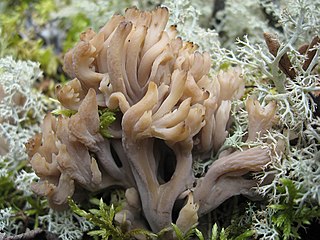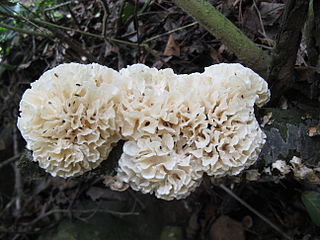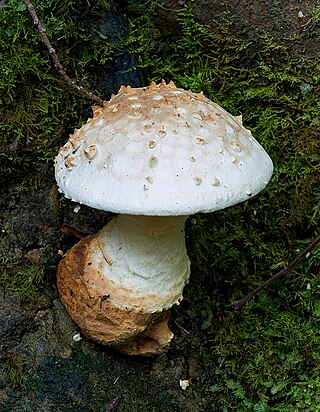
The Clavulinaceae are a family of fungi in the order Cantharellales. The family is not well defined, but currently comprises species of clavarioid fungi as well as some corticioid fungi. These species are nutritionally diverse, some being ectomycorrhizal, others wood-rotting saprotrophs, others lichenized, and yet others lichenicolous.

Gloeoporus dichrous is a species of fungus in the family Irpicaceae. First described as Polyporus dichrous by Elias Magnus Fries in 1815, it was later transferred to the genus Gloeoporus by Italian mycologist Giacomo Bresadola in 1912. The variety G. dichrous var. niger was proposed in 2008, after molecular analysis revealed the two taxa were conspecific. G. dichrous is inedible.

Phanerochaete is a genus of crust fungi in the family Phanerochaetaceae.

Giacomo Bresadola 14 February 1847 – Trento 9 June 1929) was an eminent Italian mycologist. Fungi he named include the deadly Lepiota helveola and Inocybe patouillardii, though the latter is now known as Inosperma erubescens as this latter description predated Bresadola's by a year. He was a founding member of the Société mycologique de France.

Clavulina cristata, commonly known as the wrinkled coral fungus, white coral fungus or the crested coral fungus, is a white- or light-colored edible coral mushroom present in temperate areas of the Americas and Europe. It is the type species of the genus Clavulina.

Admete is a genus of medium-sized sea snails, marine gastropod molluscs in the subfamily Admetinae of the family Cancellariidae, the nutmeg snails.

Clavulina is a genus of fungus in the family Clavulinaceae, in the Cantharelloid clade. Species are characterized by having extensively branched fruit bodies, white spore prints, and bisterigmate basidia. Branches are cylindrical or flattened, blunt, and pointed or crested at the apex, hyphae with or without clamps, basidia cylindrical to narrowly clavate, mostly with two sterigmata which are large and strongly incurved and spores subspherical or broadly ellipsoid, smooth, and thin-walled, each with one large oil drop or guttule. The genus contains approximately forty-five species with a worldwide distribution, primarily in tropical regions. Species of Clavulina are mostly ectomycorrhizal. A recent study has identified Clavulina to the genera level as present on Nothofagus menziesii adventitious roots

Ramariopsis kunzei is an edible species of coral fungi in the family Clavariaceae, and the type species of the genus Ramariopsis. It is commonly known as white coral because of the branched structure of the fruit bodies that resemble marine coral. The fruit bodies are up to 5 cm (2.0 in) tall by 4 cm (1.6 in) wide, with numerous branches originating from a short rudimentary stem. The branches are one to two millimeters thick, smooth, and white, sometimes with yellowish tips in age. Ramariopsis kunzei has a widespread distribution, and is found in North America, Europe, Asia, and Australia.
Derek Agutter Reid was an English mycologist.
Neoclitocybe byssiseda is a species of fungus in the family Tricholomataceae, and the type species of the genus Neoclitocybe. Initially described as Omphalia byssiseda by Giacomo Bresadola in 1907, it was transferred to Neoclitocybe by Rolf Singer in 1961. The mushroom is edible.

Hydnopolyporus is a genus of two species of fungi. The genus was circumscribed in 1962 by English mycologist Derek Reid with H. fimbriatus as the type species.

Clavulina cinerea, commonly known as the gray coral or ashy coral mushroom, is a species of coral fungus in the family Clavulinaceae. This grayish white edible fungus stands 2–10 cm tall, and can be found on the ground from July–October in Northeastern North America.
Clavulina amethystinoides is a species of fungus in the family Clavulinaceae. It was originally named Clavaria amethystinoides by American mycologist Charles Horton Peck in 1907; E.J.H. Corner transferred it to Clavulina in 1950.

Amanita ochrophylloides is a large mushroom of the genus Amanita native to southeastern Australia.

Saproamanita nauseosa is a species of agaric fungus in the family Amanitaceae. First described by English mycologist Elsie Maud Wakefield in 1918 as a species of Lepiota, it was named for its nauseating odor. The type specimen was found growing on soil in the Nepenthes greenhouse at Kew Gardens. Derek Reid transferred the species to Amanita in 1966, and then in 2016 the separate genus Saproamanita was created by Redhead et al. for saprophytic Amanitas and it was transferred to this new genus.
Johannes Rick was an Austrian-born Brazilian priest and mycologist considered the "father of Brazilian mycology". He was the first to systematically document the fungal biodiversity, particularly the macrofungi, of Southern Brazil. Rick established communications with several contemporary mycologists, such as Giacomo Bresadola, Curtis Gates Lloyd, Heinrich Rehm, and Hans Sydow, who helped him identify his Brazilian collections. Rick was a schoolteacher in Feldkirch from 1894 to 1898 before becoming a theology student in Valkenburg (Netherlands) from 1899 until 1902. After moving to Brazil in 1902, he was a teacher until 1915, then a social worker from 1915 to 1929, and finally Professor of theology until 1942. Between 1904 and 1911 he edited the exsiccata Fungi Austro-Americani exsiccati.

Hygrocybe reidii, commonly known as the honey waxcap, is a mushroom of the waxcap genus Hygrocybe. It was published by Robert Kühner in 1976, with the specific epithet honouring British mycologist Derek Reid. It is based on a species originally published as Hygrophorus marchii by Giacomo Bresadola in 1928, but with an insufficiently precise description, which later led to conflicting interpretations about the species concept. In 1969, Reid gave a precise description of the fungus common in Europe, but Kühner had a different interpretation of H. marchii, and gave a new name to Reid's concept of the species.

The Irpicaceae are a family of mostly polypores and crust fungi in the order Polyporales.
Elmerina is a genus of fungi in the order Auriculariales. Basidiocarps are formed on dead wood and are either bracket-like with a poroid hymenium or densely clavarioid. Species are known from East Asia and Australia.













